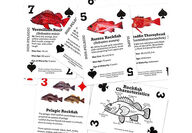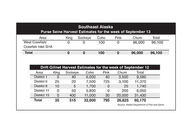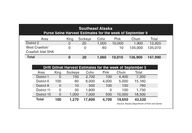Sorted by date Results 101 - 125 of 464
Lost in the headlines about the hits to seafood sales from the Trump Administration’s trade war with China is another international barrier with Russia that’s been going on far longer. In August of 2014 Russia placed an embargo on all U.S. food products to retaliate for sanctions the U.S and other Western countries imposed over the invasion of Ukraine. The ban included Alaska seafood, which at the time accounted for more than $61 million in annual sales to Russia, primarily from pink salmon roe. But here’s the bigger hurt: For the nearly six y...
Alaska lawmakers are making fast work of several fish bills that have wide support from Alaska’s fishermen. “I was anticipating a somewhat slow start, but they’re organized and they’re diving right into these issues and taking these bills up. And so there’s lots of opportunities to participate,” said Frances Leach, executive director of United Fishermen of Alaska. The bill (HB 35) that would resolve a conflict of interest fix at the state Board of Fisheries has been moving through committee hearings in Juneau and could finally be settled aft...
Alaska gets a good return on investment from its commercial fisheries. And surprise! Commercial fisheries expertise also sustains Alaska’s subsistence and most of the personal use fisheries. “This is probably not well-known,” said Sam Rabung, director of the commercial fisheries division for the Alaska Dept. of Fish and Game, at a presentation last week to the House Fisheries Committee. “Data collected by our division is shared across all divisions within the department as much as possible,” he explained to lawmakers. “We also share the cost of...
Which Alaska region is home to the most fishing boats and where do most of Alaska’s fishermen live? Answers to those questions and many others can be found in the annual report Economic Value of Alaska’s Seafood Industry 2020 by the Alaska Seafood Marketing Institute (ASMI). The colorful, easy to read report, prepared by the McDowell Group, gives a fishing snapshot by Alaska region, including employment rates and tax revenues, and breaks down the industry’s impacts to the nation and the world. Here are some highlights: The seafood indus...
It’s been a long time coming but payments should soon be in hand for Alaska fishermen, processors and coastal communities hurt by the 2016 pink salmon run failure, the worst in 40 years. The funds are earmarked for Kodiak, Prince William Sound, Chignik, Lower Cook Inlet, South Alaska Peninsula, Southeast Alaska and Yakutat. Congress ok’d over $56 million in federal relief in 2017, but the authorization to cut the money loose languished on NOAA desks in DC for over two years. The payouts got delayed again last October when salmon permit hol...

Alaskans saw salmon die offs last summer across the state when water temperatures soared into the mid-70s to above 80 degrees in some regions. But what about threats to salmon from the accompanying global gorilla - increased acidity? It’s a shock to learn that while extensive studies for years have been underway by Alaska scientists on impacts to major fish and shellfish stocks, there’s been none done in Alaska for salmon. In fact, only two lab studies have been done on Alaska salmon, both out o...
Every year since 1991 Fish Factor has selected “picks and pans” for Alaska’s seafood industry - a no-holds-barred look back at some of the year’s best and worst fishing highlights, and my choice for the biggest fish story of the year. Here are the 2019 picks and pans, in no particular order - Best fish scientist – Dr. Bob Foy, director of science and research at NOAA’s Alaska Fisheries Science Center/Juneau – No one explains science better or with more passion. Biggest new business potential: Mariculture. Alaska is acting on plans to grow a $10...
Alaska’s seafood industry will be “open for business” starting January 1 when some of the biggest fisheries get underway long before the start of the first salmon runs in mid-May. Cod will begin it all in the Bering Sea, which has a 305.5 million pound catch quota, down about a million pounds from 2019. Less than 6 million pounds of codfish will come out of the Gulf. A 400,000 Tanner crab fishery at Kodiak starting on January 15 will be helpful to a town whose economic bottom line will be badly battered by the Gulf cod crash. But it will be th...
They say good things come in small packages and that’s the case for Alaska cod fishermen heading into the new year. A small cod fishery will occur in Gulf state waters (out to three miles) for 2020, putting to rest speculation that no cod would be coming out of the Gulf next year. A catch quota of about 5.6 million pounds, down from 10.2 million pounds, will be split among five regions: Prince William Sound, Cook Inlet, Kodiak, Chignik and the South Alaska Peninsula, with limitations on gear and staggered openers. That will be a relief to thous...

Go Fish! A deck of clever playing cards is teaching people about one of Alaska's most popular yet fragile fishing favorites: rockfish. During games players can learn how to identify the 48 different kinds of rockfish found in Alaska waters and how some, like rougheye, can live beyond 200 years. "Shortraker, the 10 of diamonds, can live 157 years. Yelloweye live 118 years and are sexually mature at around 22 years. Black rockfish mature at six or seven years and can live to be 50 years," said...
Lower catches for Pacific halibut are in the forecast for the foreseeable future. That was the message from the International Pacific Halibut Commission at its meeting last week in Seattle. The IPHC oversees halibut stock research and sets catch limits for nine fishing regions ranging from Northern California and British Columbia to the Bering Sea. There are fewer of the prized flatfish (down 4%), they weigh less (down 5%) and no big pulses appear to be coming into the stock was the grim and the results of summer long surveys at nearly 1,370...
The value of Alaska salmon permits has ticked upwards in regions that experienced a good fishery this year while others have tanked. Not surprisingly, the record sockeye fishery at Bristol Bay has boosted sales of driftnet permits to nearly $200,000, up from the mid-$170,000 range prior to the 2019 season. Another strong run forecast of 48.9 million sockeyes for 2020 with a projected harvest of 36.9 million could increase the value even more, said Doug Bowen of Alaska Boats and Permits in Homer. What’s really raising eyebrows, Bowen said, is v...
Alaska’s 2019 salmon season was worth $657.6 million to fishermen, a 10% increase from the 2018 fishery. Sockeye salmon accounted for nearly 64% of the total value, topping $421 million, and 27% of the harvest at 55.2 million fish. Those are the lead takeaways in a summary from the Alaska Department of Fish and Game that reveals preliminary estimates of salmon harvests and values by region. The final values will be determined in 2020 after processors, buyers, and direct marketers submit their totals paid to fishermen. Pink salmon were the s...
The federal government’s plan to raze more roads through the Tongass National Forest is facing strong headwinds from fishermen, Native groups and coastal communities throughout Southeast Alaska. Over 220 Southeast Alaskan fishermen signed a letter to the Trump Administration last week opposing the abrupt push to exempt the Tongass National Forest from a roadless rule in place for over a decade. The exemption would release more than 9 million acres from protection and open nearly 200,000 acres to logging. The U.S. Forest Service made the a...
They are certainly cute but the voracious appetites of sea otters continue to cause horrendous damage to some of Southeast Alaska’s most lucrative fisheries. How best to curtail those impacts will be the focus of a day long stakeholders meeting set for November 6 in Juneau. “All of the people who have anything to do with the otters hopefully will all be in the same room at the same time,” said Phil Doherty, co-director of the Southeast Alaska Regional Dive Fisheries Association (SARDFA) based in Ketchikan. A 2011 report by the McDowell Group...
As more Alaskans eye the lucrative opportunities in growing kelp, many others are heading to beaches at Lower Cook Inlet to commercially harvest the detached bunches that wash ashore. That practice is now getting a closer look by state managers and scientists and could result in new regulations by year’s end. Detached kelp harvests have occurred at Lower Cook Inlet under special permits since the 1970s but matters of who needs permits, for how much and for what purposes are not clearly defined. Currently, a special permit is needed for c...
Hundreds of fishery stakeholders and scientists will gather in Anchorage next week as the state Board of Fisheries (BOF) begins its annual meeting cycle with a two-day work session. The seven-member BOF sets the rules for the state’s subsistence, commercial, sport and personal use fisheries. It meets four to six times each year in various communities on a three-year rotation; this year the focus is on Kodiak and Cook Inlet. The fish board and the public also will learn the latest on how a changing climate and off kilter ocean chemistry are a...
Halibut catches fluctuate based on the ups and downs of the stock from California to the farthest reaches of the Bering Sea. If the numbers decline, so do the catches of commercial and sport fishermen. But similar reductions don’t apply to the boats taking millions of pounds of halibut as bycatch in other fisheries. In the Bering Sea, for example, there is a fixed cap totaling 7.73 million pounds of halibut allowed to be taken as by catch for trawlers, longliners and pot boats targeting groundfish, with most going to trawlers. The cap stays t...
The nation’s farmers of the sea are hoping for a helping hand from Uncle Sam to train future generations of fishermen. It would mirror programs in place for nearly 160 years for U.S. farmers and ranchers. Federal backing of training programs for entry level farmers and ranchers can be traced back to the 1862 Morrill Land-Grants Act. Beginning in 2009, Congress authorized $75 million for the Beginning Farmer and Rancher Development Program (BFRDP) to “develop and offer education, training, outreach and mentoring programs to enhance the sus...
Federal stewards of Alaska’s fisheries will meet in Homer for the first time since 1983 as they continue their pursuit of involving more people in policy making. From September 30 to October 10, the Spit will be aswarm with entourages of the 15 member North Pacific Fishery Management Council which oversees more than 25 stocks in waters from three to 200 miles offshore, the source of most of Alaska’s fish volumes. The NPFMC is one of eight regional councils established by the Magnuson-(Ted) Stevens Fishery Conservation and Management Act in 197...

"Unpredictable" is the way salmon managers describe Alaska's 2019 salmon season, with "very, very interesting" as an aside. The salmon fishery is near its end, and a statewide catch of nearly 200 million salmon is only six percent off what Alaska Dept. of Fish and Game number crunchers predicted, and it is on track to be the 8th largest since 1975. The brightest spot of the season was the strong returns of sockeye salmon which produced a catch of over 55 million fish, the largest since 1995 and...

Federal agencies are meeting now through next March to define U.S. dietary guidelines for 2020-2025, and a high powered group of doctors and nutritionists are making sure the health benefits of seafood are front and center. For the first time in the 40 year history of the program, the dietary guidelines committee has posted the questions they are going to consider. They include the role of seafood in the neurocognitive development in pregnant moms for their babies, and in the diet of kids from b...
Now the shuffling begins at Alaska fisheries offices around the state as the impacts from back and forth veto volleys become more clear. For the commercial fisheries division of the Alaska Dept. of Fish and Game, an $85 million budget, about half of which is from state general funds, reflects a $997,000 dollar cut for FY 2020. Where and how the cuts will play out across Alaska’s far flung coastal regions is now being decided by fishery managers. “Now that the salmon season is about over we’re taking a good close look at this and what we’re...
Underwater and out of sight are the makings of a major Alaska industry with two anchor crops that clean the planet while pumping out lots of cash: shellfish and seaweed. Alaskans have now applied for over 2,000 acres of new or expanding undersea farms, double the footprint from two years ago, ranging in size from .02 acres at Halibut Cove to nearly 300 acres at Craig. Nearly 60 percent of the newest applicants plan to grow kelp with the remainder growing a mix of kelp and/or Pacific oysters, said Cynthia Pring-Ham, aquatic farming coordinator a...
Investment that comes from within, not from without, is the motivation behind a boot camp that will jump start and nurture businesses in communities throughout Bristol Bay. Through September 15 locals with good ideas, start-ups or existing businesses across the region will compete to attend a three day boot camp that provides in-depth business education, networking and advice. First, they must make the grade in a simple application process. The 10 or 12 who make that cut will go to the boot camp and be judged on business feasibility and...